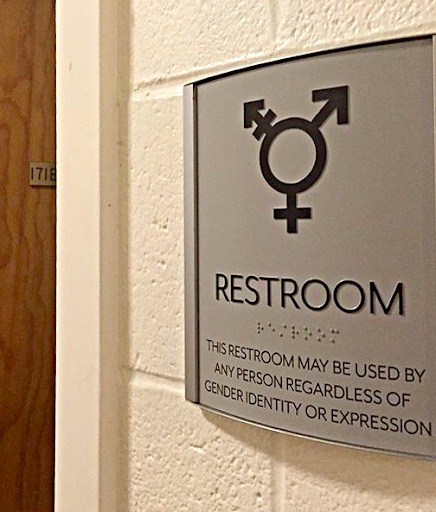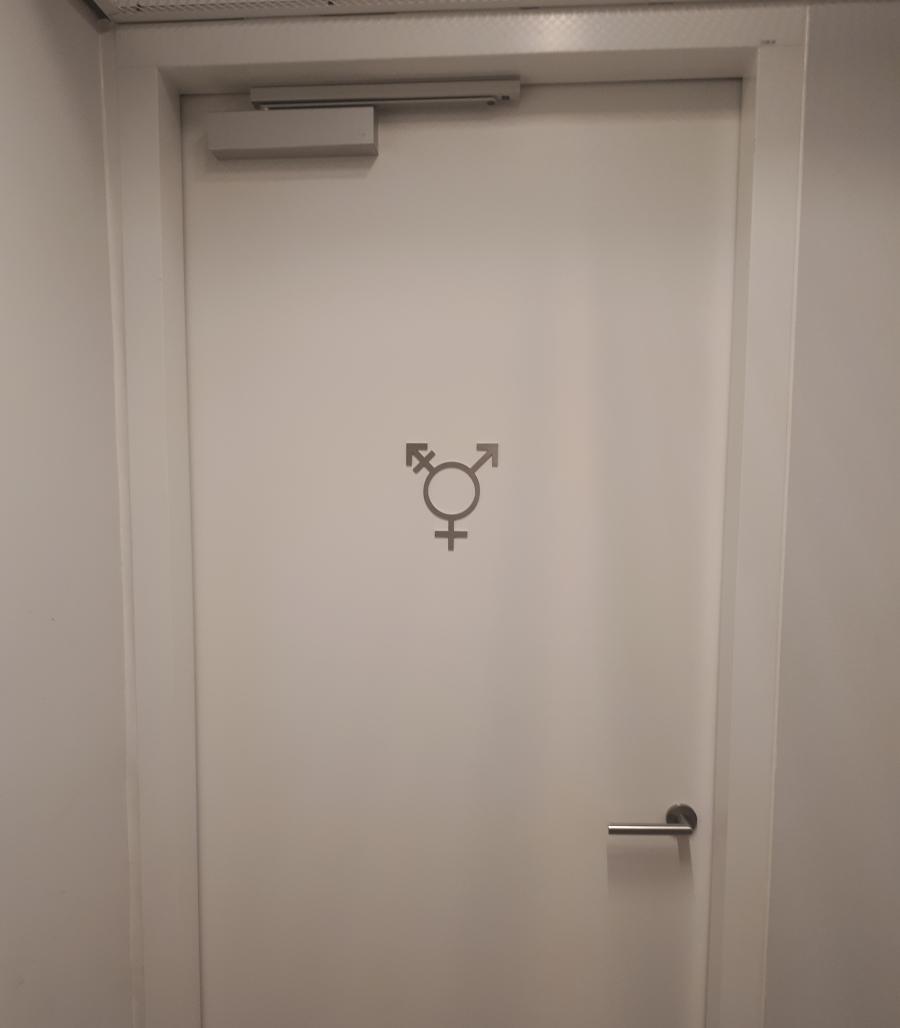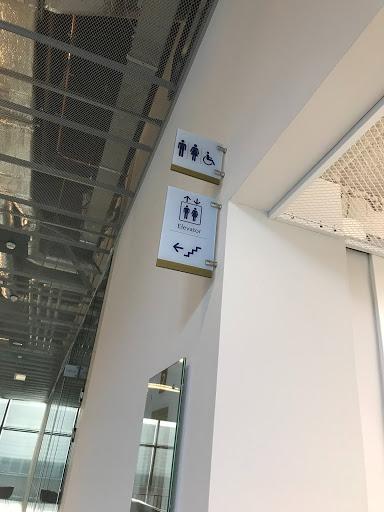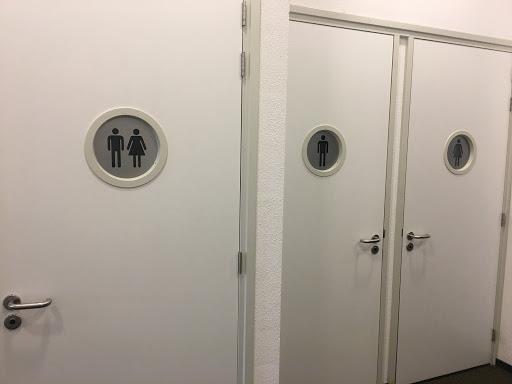
Gender-neutral bathrooms: overkill or vital?
There is one thing we can find in every public place, school, university and workplace: bathrooms. Tilburg University moves with the times and adapts to evolving social norms. This can be seen in the newest building, the Cube, with the introduction of gender-neutral bathrooms. These have become a heated discussion topic. Are gender-neutral bathroom signs necessary? And how can that be seen at Tilburg University?
When terms such as transgender and non-binary are mentioned, this refers to all people who do not identify as cisgender. Cisgender means that someone’s gender identity corresponds with the identity they were assigned at birth.
The historical significance of bathroom signs
While it might feel like bathroom signs have been around since the beginning of time, this is definitely not true. While pictograms and symbols have been prevalent for quite a while, the rise of international pictograms began in Vienna, around 1924. This was as a result of the city’s Social and Economic Museum looking to present their data in a way that was comprehensible for all visitors, so numbers were replaced with pictograms. This system was eventually named Isotype (International System Of Typographic Picture Education), and it gained popularity around the world. The British Rail was one of the first big corporations to implement a standard sign design for all bathrooms in the 1960s. This was because of mass tourism and the increasingly globalized economy: it created a language that could be universally understood. The U.S. followed suit in the ‘70s by adopting a system for comprehensive bathroom signs throughout their public transportation networks. The American Institute of Graphic Arts developed a set of thirty-four symbols (today we use 50), which are still as easily interpreted now as they were 40 years ago.

Figure 1: 3 examples of the pictograms developed by the American Institute of Graphic Arts
Bathroom signs are something which will always be necessary, no matter how advanced technology gets. While there certainly are many options for indicating which lavatory is which, these stick figures will always be clear to everyone, including foreigners.
However, while technological development might not cause bathroom signs to become unnecessary, the development of bathroom signs might be necessary to properly address everyone.
A gender-neutral toilet can be seen simply as a development of the traditional ones that we're familiar with.
This is where gender-neutral signs step into the picture. The first gender-segregated public restroom on record was a temporary setup at a Parisian ball in 1739, says Sheila Cavanagh, a sociologist at York University in Canada. The notion of gender-neutral or unisex bathrooms is actually not that revolutionary, as it was the norm in the past. However the modern-day debate about the bathroom bill is. Gender-neutral toilets started appearing again around 2015. While the idea wasn’t entirely new, the context in which it appeared was. While there is no distinct or universally agreed on symbol for a unisex lavatory, the most commonly used and recognized ones are either a combination of the traditional male and female stick figures, or a symbol using the signs representing both male (♂) and female (♀). In this way, a gender-neutral toilet can be seen simply as a development of the traditional ones that we're familiar with.

Figure 2: A gender-neutral bathroom sign.
Comparing different bathroom signs
Bathroom symbols can be seen in public spaces and in this case on the Tilburg University campus. There are figures of men, women, and someone in a wheelchair. The gender-neutral symbol is a combination of the male, female and transgender symbol. Tilburg University is an international university and by using these symbols everyone can understand what it means. The specific function of the pictograms is to know which bathroom to use. Not every building has a gender-neutral bathroom, but by combining the different familiar symbols people automatically know that the bathroom is accessible for all.
Linguistic landscaping refers to all visible semiotic signs in public space, which includes the various bathroom signs seen at the university. The varied differences between bathroom signs can be found very close to each other. Last summer a new building was built on campus, called the Cube. It is a very modern building and it is no surprise that there are modern bathrooms. Most bathrooms have the traditional men, women and disabled signs, but one of the new bathrooms has a gender-neutral sign.
The Cube has bathrooms for women, men, and disabled people. It is, therefore, possible to make a choice of which bathroom to use. The gender-neutral bathroom is the only one in this building. The hidden message behind this sign can be explained by the use of indexicality. Indexicality is the social meaning behind language and symbols that can be implicitly understood. The indexicality behind this sign is that everyone is welcome and wanted at Tilburg University. Although there is only one gender-neutral bathroom, it does imply that Tilburg University wants to adapt to recent social changes and show students that they are accepted and valued, regardless of gender identity.

Figure 3: Gender-neutral bathroom in the newest building of Tilburg University. Taken the 18th of December.

Figure 4: Gendered and handicapped bathroom in the newest building of Tilburg University. Taken the 18th of December.
A diversity in bathrooms can also be found in the Intermezzo building on the Tilburg University campus. Pictured below you can see that there are traditional toilets for women and men. It is notable that they also have a bathroom for both men and women, but this does not necessarily imply that this is a gender-neutral bathroom. A possible explanation could be that they had a spare room, which now is shared by both sexes, but could also imply a gender-neutral bathroom.

Figure 5: Bathroom in the Intermezzo building. Taken the 18th of December.
Two sides to every argument
The number of gender-neutral bathrooms is increasing, which means that discussions about them are increasing as well. One argument against gender-neutral bathrooms that is mentioned frequently is the level of discomfort which these bathrooms could bring. Many universities in the Netherlands, but also abroad, are becoming more inclusive by adding gender-neutral bathrooms. Utrecht University was one of the first in the Netherlands toexperiment with gender-neutral bathrooms (Waterlander, 2018). Most criticisms voiced in the article written by Waterlander reflect that people do not want to give up their privacy, that women would feel uncomfortable doing their make-up with men present, and hygiene standards would be comprised. A woman cited in his article claims: “I want a clean toilet. If men use it, everything becomes messy.”
For some people, there could also be a religious issue. The University of Bristol has mentioned in a statement that they want to be inclusive to non-binary people, but also want to respect people’s religious or cultural reasons by ensuring that both types of bathrooms, gender-neutral and gendered bathrooms, are available across the whole campus. Van Helmondt researched whether this would be a problem for Muslim women. He concluded that there is not a single right answer, because there are many different movements within the religion that all have their own ideas (van Helmondt, as cited in Waterlander, 2018).
Some opponents mention that instead of gender-neutral toilets, non-binary people should use bathrooms for disabled people as a solution.
Another possible problem could be that the costs outweigh the demand. Smith mentioned that there has been an investment worth 3.4 million to upgrade Bristol University’s toilet facilities. The costs depend on the changes that need to happen. If a whole new bathroom needs to be installed, it will cost significantly more than repurposing an already existing bathroom (Campbell, 2016). As Ficheroux mentions in his article:
“You don’t need much to make one either: simply stick a sign with a ‘gender-neutral’ symbol on a few accessible toilets and Bob’s your uncle.”
Some opponents mention that instead of gender-neutral toilets, non-binary people should use bathrooms for disabled people as a solution. The most logical response to this is that being non-binary, or not defining oneself as either male or female, is not a disability. Van Helmondt says that “the goal of the gender-neutral bathroom is to make as little distinction as possible based on gender.” So, by ‘making’ non-binary people use the bathrooms for the disabled, you are making the distinction very explicit.
Bathrooms are supposed to be facilities free for all to use but the traditional kind of signs portray a certain hostility towards trans and gender-diverse people by focussing on the way they look and what they wear:
“The familiar signage silhouettes of male and female that mark our public bathrooms reduce gender identity down to our bodies and clothing. Not only do they reinforce outdated gender stereotypes, they erase non-binary people.” (Castricum, 2018)
Making bathrooms more inclusive to non-binary people does not mean that bathrooms become exclusive to cisgender people.
People who do not identify as cisgender should not be afraid of discrimination and harassment for such a basic human right. Having to use gendered bathrooms puts a spotlight on their insecurities everywhere they go.
Using gendered toilets is not an option for non-binary people, since no one should be put into a highly uncomfortable situation like this on a regular basis. This is not the case when adding gender-neutral bathrooms, since cisgender people would still be able to use gendered toilets. Adding more gender-neutral bathrooms is not a huge problem, since changing a sticker is enough in many cases. Making bathrooms more inclusive to non-binary people does not mean that bathrooms become exclusive to cisgender people.
Overkill or vital?
Bathroom signs have gone through a gradual development, but now day-to-day life almost wouldn't be possible without them. Gender-neutral signs are regarded as necessary. Nowadays, many people dare to come out for the fact that they identify themselves as something other than cisgender. It is important that these people feel welcome and comfortable in public spaces. Making bathrooms a welcoming place for everyone does not mean that cisgender people are not welcome anymore. We have seen that Tilburg University contributed to this discussion by making gender-neutral bathrooms.
References
Campbell, C. (2016). The Real Cost of Gender-Neutral Restrooms.
Castricum, S. (2018). Public bathrooms are gender identity battlefields. What if we just do it right?
Debczak, M. (Dec 28, 2015). How Bathroom Stick-Figures Became Universal Symbols.
Express.co.uk. (2018). British university to spend £3.4 million on gender-neutral toilets.
Ficheroux, T. (2017). Urgent need for gender-neutral toilets?
Glancey, J. (Sep 11, 2014). The Genius Behind Stick Figure Toilet Signs.
Pappas, S. (May 9, 2016). The Weird History of Gender-Segregated Bathrooms.
Popova, M. (Mar 9, 2011). The Stuff of Life: The Origins of Bathroom Signs.
Waterlander, A. (2018). Three UU buildings to have gender-neutral bathrooms.